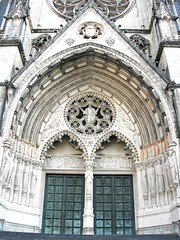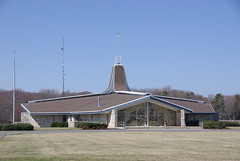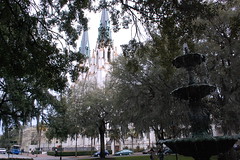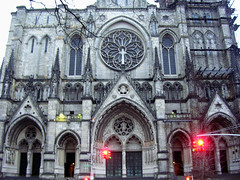The founders of the Cambridge-Camden Society believed the antidote to the evils of the 19th century was a return to medieval piety. Their early thrust was restoration of the medieval architectural setting for worship in the Anglican Church. Their generosity of advice was paired with their prickly attitude toward anyone who did not accept it wholeheartedly. Their zeal extended to “the colonies” which resulted in one of the most charming and influential churches in America, St. James-the-Less in Philadelphia. (The Society lives on with only a short break in continuity as The Ecclesiolgoical Society.)
In response to a request to the Society for design assistance with their Episcopal church, the Pennsylvania congregation received measured drawings of a 13th century parish church, St. Michael’s, Longstanton, Cambridgeshire. The congregation faithfully reproduced the model high above the Schuylkill River, changing only the length of the structure and selection of stone in the 1846 construction.
In fine ecclesiological fashion, the nave and long chancel are clearly expressed in the exterior massing of the building. The later addition of the sacristy only enhanced the picturesque composition – a guiding principal of the increasingly archeological Gothic Revival. The long steep rooflines, as seen on the south porch entrance enhance the sense of shelter and worshipful repose.
On a recent visit, the cold, drizzly day seemed appropriate to the disuse into which St. James-the-Less has fallen in the past several years. This is not to be blamed on neglect. The too-familiar story is of a congregation, rejecting the theological trajectory of the Episcopal Church, disaffiliated itself from the denomination. The odd result of legal wrangling held that the congregation owned the church building, but held it in trust for the diocese, who evicted them. We should not force too much irony on the fact that the congregation now worships in a nearby cemetery chapel – as much of charm of St. James-the-Less is its setting among gravestones, old and not-so-old.
Given the situation, we had no expectation that we could even gain access for exterior photography. Happily, we were greeted by a young man associated with another diocesan church, who was waiting for visiting group. He offered to let us tag along with a small group of clerics from the Reformed Catholic Church.
That ushered us into the church where darkness and sight lines obstructed by columns and by a rich rood screen were a reminder that lay participation in the medieval mass, celebrated in the divided chancel, was decidedly passive. Electric lighting struggled against the shadows, while the discoloration of the arcade springing was attributed to match strikes for the original chandeliers. Discolored stone on the pulpit indicated a hand rest for the deliverers of countless sermons.
In addition to the pulpit, the expected liturgical centers were there, altar, lectern, font, side chapel. The stained glass was obviously there to set a mood and tell a story rather than provide illumination.
St James the Less has been assumed as a mission by St Mark’s, the historic John Notman church in Center City Philadelphia. They should have experience and skill in preserving and using a historic structure. Let’s hope that they can do that. Nothing leads to loss like disuse. Nothing preserves like an active, resident congregation. Loss or damage of St. James-the-Less would be tragic from an architectural standpoint. From a spiritual standpoint, good stewardship demands a Kingdom use of this treasure.
UPDATE: I had a pleasant email exchange with Father Ousley, rector of the congregation formerly at St James. He confirms that the attribution of marks on the column springing to match strikes is in a written church history. However they have determined that the discoloration is from greens hung at Christmas. The congregation presently worships at the chapel at West Laurel Hill Cemetery. He also relates, "West Laurel Hill was founded by the same gentlemen who founded Laurel Hill Cemetery, and gave St James the first part of the land on which it is built. A nice historical touch."










